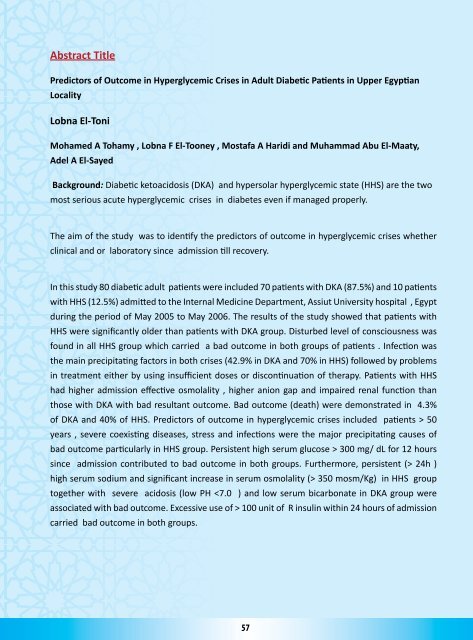Download Booklet - Diabetes in Asia Study Group
Download Booklet - Diabetes in Asia Study Group
Download Booklet - Diabetes in Asia Study Group
You also want an ePaper? Increase the reach of your titles
YUMPU automatically turns print PDFs into web optimized ePapers that Google loves.
Abstract Title<br />
Predictors of Outcome <strong>in</strong> Hyperglycemic Crises <strong>in</strong> Adult Diabetic Patients <strong>in</strong> Upper Egyptian<br />
Locality<br />
Lobna El-Toni<br />
Mohamed A Tohamy , Lobna F El-Tooney , Mostafa A Haridi and Muhammad Abu El-Maaty,<br />
Adel A El-Sayed<br />
Background: Diabetic ketoacidosis (DKa) and hypersolar hyperglycemic state (hhs) are the two<br />
most serious acute hyperglycemic crises <strong>in</strong> diabetes even if managed properly.<br />
the aim of the study was to identify the predictors of outcome <strong>in</strong> hyperglycemic crises whether<br />
cl<strong>in</strong>ical and or laboratory s<strong>in</strong>ce admission till recovery.<br />
<strong>in</strong> this study 80 diabetic adult patients were <strong>in</strong>cluded 70 patients with DKa (87.5%) and 10 patients<br />
with hhs (12.5%) admitted to the <strong>in</strong>ternal Medic<strong>in</strong>e Department, assiut university hospital , egypt<br />
dur<strong>in</strong>g the period of May 2005 to May 2006. the results of the study showed that patients with<br />
hhs were significantly older than patients with DKa group. Disturbed level of consciousness was<br />
found <strong>in</strong> all hhs group which carried a bad outcome <strong>in</strong> both groups of patients . <strong>in</strong>fection was<br />
the ma<strong>in</strong> precipitat<strong>in</strong>g factors <strong>in</strong> both crises (42.9% <strong>in</strong> DKa and 70% <strong>in</strong> hhs) followed by problems<br />
<strong>in</strong> treatment either by us<strong>in</strong>g <strong>in</strong>sufficient doses or discont<strong>in</strong>uation of therapy. patients with hhs<br />
had higher admission effective osmolality , higher anion gap and impaired renal function than<br />
those with DKa with bad resultant outcome. bad outcome (death) were demonstrated <strong>in</strong> 4.3%<br />
of DKa and 40% of hhs. predictors of outcome <strong>in</strong> hyperglycemic crises <strong>in</strong>cluded patients > 50<br />
years , severe coexist<strong>in</strong>g diseases, stress and <strong>in</strong>fections were the major precipitat<strong>in</strong>g causes of<br />
bad outcome particularly <strong>in</strong> hhs group. persistent high serum glucose > 300 mg/ dL for 12 hours<br />
s<strong>in</strong>ce admission contributed to bad outcome <strong>in</strong> both groups. furthermore, persistent (> 24h )<br />
high serum sodium and significant <strong>in</strong>crease <strong>in</strong> serum osmolality (> 350 mosm/Kg) <strong>in</strong> hhs group<br />
together with severe acidosis (low ph 100 unit of r <strong>in</strong>sul<strong>in</strong> with<strong>in</strong> 24 hours of admission<br />
carried bad outcome <strong>in</strong> both groups.<br />
57


